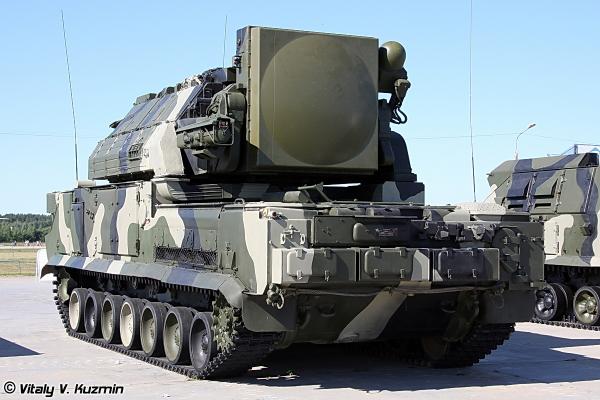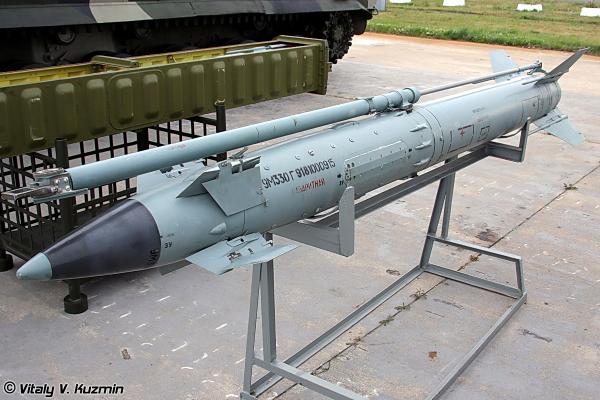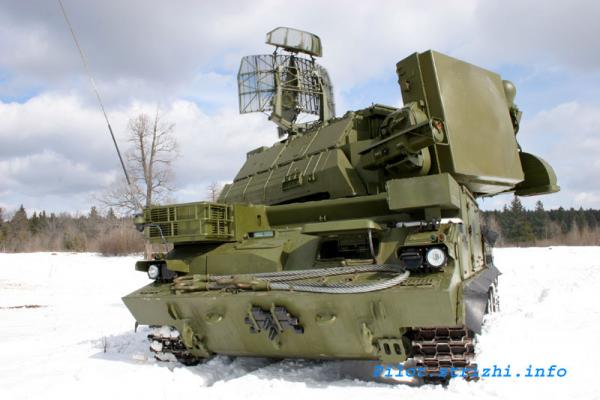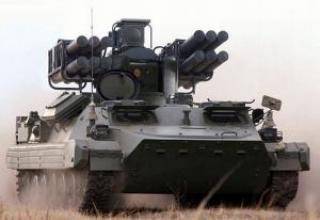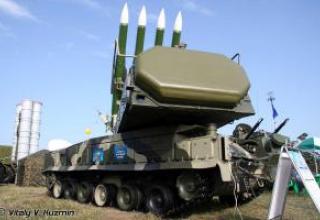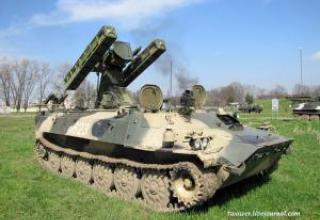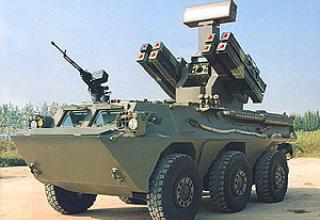Work on the creation of a divisional autonomous self-propelled air defense missile system "Tor" (9K330) began in accordance with the Decree of the CPSU Central Committee and the USSR CM dated February 4, 1975 and continued until 1983. In parallel with the development of SAMs for the Ground Forces were deployed work on a partially unified with it ship complex "Dagger".
In addition to the traditional task of fighting manned aviation, the military SAMs were to provide defeat and aircraft means of destruction - air-to-ground missiles, planning aircraft bombs such as "Wallay", as well as cruise missiles such as ASALM and ALCM, remotely-piloted aircraft (UAV) type BGM-34. The effective solution of these tasks required the automation of the entire combat process and the use of more advanced radars.
The changed views on the nature of possible combat operations removed the obligation to fulfill the requirement for the military anti-aircraft systems to force water obstacles in the water, but determined the need to provide these SAMs for combat vehicles with the same speed and cross-country ability as the tanks and BMPs of the covered units. Combined with the need to increase the ammo system of SAMs, this resulted in the transition of the divisional SAMs from wheeled to heavier tracked chassis.
The scheme of vertical missile launches worked out during the development of the S-300 anti-aircraft missile systems made it possible to implement a similar technical solution in the Tor SAM system by vertically placing eight SAMs along the axis of the combat vehicle's turret, protecting them from adverse weather effects and from shell and bomb fragments.
The main designer of the Tor SAM system was determined by NIIEMI MRP (formerly NII-20 SCRE). V.P. Efremov was appointed the chief designer of the complex as a whole, and I.M. Drize was appointed the combat vehicle 9A330 of this SAM. The 9M330 SAM for the Tor complex was developed by the MAP Fakel ICBM (former Design Bureau-2 of the GKAT) headed by P.D. Grushin.
Composition:
Combat vehicle 9A330 (see projections, photos 1, 2, 3, 4, 5, 6, 7) had in its composition:
- Target Detection Station (TDS) with systems of identification of their nationality and stabilization of the antenna base;
- a pointing station (TSS), with one target channel, two missile channels and a channel for the LSD capture coordinator;
- a special computer;
- a launching device that provided for the vertical, alternate launch of the eight SAMs in a combat vehicle,
- equipment of various systems of starting automatics, navigation and top linking systems, documentation of the combat operation process, systems of functional control of the combat vehicle, autonomous power supply (based on gas-turbine generator) and life support.
The missiles are located in the launch vehicle without transport containers and are launched vertically using powder catapults. The vehicle's launch vehicle and antennae were structurally combined into an antennae launcher that rotates relative to the vertical axis.
All these technical facilities were located on the self-propelled tracked chassis of high cross-country ability developed by Minsk Tractor Plant GM-355, unified with the chassis of the anti-aircraft gun and missile system "Tunguska". The weight of the combat vehicle with eight SAMs and a combat strength of 4 persons was 32 tons.
Solid fuel ZUR 9M330 (see diagram) is made according to the scheme "duck" and equipped with a device that provides gas-dynamic declination. Folding wings were used in the rocket, which were opened and fixed in flight positions after the launch of the ZUR. In the transport position, the left and right consoles were folded towards each other. The missile was equipped with an active radio detonator, an autopilot with rudder drives, a radio bundle, a shrapnel-type combat unit with a safety executive mechanism, a power supply system, a gas-supply system for the rudder drives on the march and gas-dynamic rudders at the launch site. On the outer surface of the missile body were placed the antennas of the radio detonator and radio unit, and also installed a powder ejector. The rockets were loaded into the combat vehicle using the complex's transport and charging vehicle.
At launch, the missile was ejected by catapult vertically at a speed of about 25 m/s. The inclination of the SAM at a given angle, the magnitude and direction of which was introduced before the start of the autopilot from the guidance station, was carried out before the launch of the rocket engine as a result of the expiration of the combustion products of a special gas generator through four two-nozzle blocks of the gas distributor, installed at the base of the aerodynamic rudder. Gas ducts leading to oppositely directed nozzles are blocked, depending on the angle of rotation of the rudder. Combining the aerodynamic rudder and the gas distribution unit into a single unit allowed to exclude the use of a special drive for the declination system. The gas-dynamic device inclines the rocket in the required direction, and then stops its rotation before switching on the solid fuel engine.
The launch of the SAM engine was carried out at an altitude of 16-21 m from the ground (either after the specified one-second delay from the launch, or after reaching the angle of deviation of the missile's axis from the vertical 50°). In this way, the entire RTR pulse is used to speed the missile towards the target. After launch, the rocket started to gain a speed of 700-800 m/s at a range of 1.5 km. The command guidance process began at a range of 250 m. Due to a wide range of linear sizes (from 3-4 to 20-30 m) and parameters of target movement (from 10 to 6000 m in height and from 0 to 700 m/s in speed) for the optimal coverage of high-flying targets with fragments of the BC from the pointing station on board the SAM system were given a delay value of the radio detonator, depending on the speed of approaching the missile to the target. At low altitudes, the underlying surface was selected and the radio detonator was triggered only from the target.
The target detection station was a coherent-pulse radar with a circular view of the centimetre wavelength range with frequency control of the beam at an angle. The beam (particle) 4° wide at an angle of position and 1.5° azimuth could occupy eight positions in the angular plane, overlapping the 32° sector. It could be viewed simultaneously at an angle in three parcells. The order of visibility by the pistons was set by a special computer program.
The basic mode of operation provided for a viewing pace of the detection area in 3 seconds, with the lower part of the area being viewed twice. If necessary, it was possible to provide an overview of the space in the three selected packs at a rate of 1 s. Markings with coordinates of up to 24 detected targets were tied into trails (up to ten traces). The commander's indicator showed the targets in the form of points characterizing the magnitude and direction of its speed vectors, next to which there were displayed the forms containing the trace number, the target number according to the degree of danger (according to the minimum time of entering the affected area), the number of the particle in which the target was, and the sign of the operation performed (search, escort, etc.). When operating in strong passive interference, the target detection station was able to blanket the signals from the interference-inhibited direction and distance to the target. If necessary, it was possible to enter into the computer the coordinates of the target from the sector of the blanks to produce the target designation by manual overlaying of the marker on the target covered by the interference and manual pinching of the marker.
The resolution of the target detection station was no worse than 1.5°-2° azimuth, 4° angle and 200 m range. Maximum target coordinate errors were no more than half of the resolution values indicated.
With an average transmitter power of 1.5 kW and a receiver noise figure of 2-3, the target detection station provided detection of F-15 type aircraft flying at altitudes from 30 to 6000 m at ranges of 25-27 km with a probability of not less than 0.8 (unmanned aerial vehicles - at ranges of 9-15 km with a probability of not less than 0.7). Helicopters with spinning propellers on the ground were found at ranges of 6-7 km with a probability of 0.4-0.7, hovering in the air at 13-20 km with a probability of 0.6-0.8, and jumping from the ground to an altitude of 20 m - 12 km with a probability of at least 0.6.
The suppression factor of signals reflected from local objects in the digital reception channel of the target detection station system exceeded 44 dB, in analog channels - 40 dB.
Protection against anti-radar missiles was provided by their detection and defeat by their SAMs.
The guidance station was a coherent pulsed radar of a centimeter-wide water range with a small-element phased array antenna (PHAR), which formed a beam 1° wide along the azimuth and angle of the place and provided electronic scanning of the beam in the corresponding planes. The station provided a 3° azimuth and 7° angle search for a target in the sector, auto tracking of one target at three coordinates by monopulse method, launching of one or two SSDs (at 4s intervals) and their guidance.
Commands were transmitted aboard the SSD by a single station transmitter through the PHAR. The same antenna provided simultaneous measurement of target coordinates and two directional sounders by means of electronic scanning of the beam. The frequency of the beam to each object was 40 Hz.
The resolution of the pointing station was not worse than 1 m azimuth and in the angle of place, 100 m in range. Mean-square errors of auto tracking of the fighter were no more than 0.3 d. in azimuth and angle of position, 7 m in range and 30 m/s in speed. RMS errors of ZR escort in azimuth and angle of position were of the same order, in range - no more than 2.5 m.
With an average transmitter power of 0.6 kW and a sensitive 4x10E-13W receiver the guidance station provided a range of 23 km with a probability of 0.5 and 20 km with a probability of 0.8.
Characteristics:
| Defeat zone, km: - at a distance - in height - as defined in |
1,5..12 0,01..6 6 |
| Probability of hitting a single ZUR fighter. | 0,26..0,75 |
| Maximum target speed (inhaling/attacking) m/s | 700 |
| Response time, s: - from the point of view of - at a quick stop |
8,7 10,7 |
| ZUR flight speed, m/s | 700..800 |
| Mass of the rocket, kg | 165 |
| Weight of combat unit, kg | 14,5 |
| The length of the rocket, mm | 2898 |
| The diameter of the rocket body, mm | 235 |
| Wingspan, mm | 650 |
| Number of target channels | 1 |
Testing:
Tests of the SAM system "Tor" was held from December 1983 to December 1984 at the Emba test site under the leadership of a commission headed by R.S. Asadulin. By a decree of the CPSU Central Committee and the USSR CM of March 19, 1986 SAM system was adopted.
Series production of the 9A330 combat vehicle was organized at the Izhevsk Electromechanical Plant MRP, ZUR 9M330 - at the Kirov Machine-Building Plant named after XX MAP, tracked chassis - at the Minsk Tractor Plant IUFM.
The complex provided defeat of the target flying at a speed of 300 m/s at altitudes from 0.01 to 6 km in the range of 1.5 to 12 km with the parameter up to 6 km. At a target speed of 700 m/s, the maximum range was reduced to 5 km, the range of engagement height was narrowed to 0.05 to 4 km and the parameter did not exceed 4 km.
The effectiveness of a single SAM was 0.30-0.77, 0.50-0.88 for helicopters and 0.85-0.955 for UAVs.
The reaction time of the complex was 8 ... 12 seconds, the transfer to combat and marching positions - 3 minutes, the charging of the combat vehicle with TZM - no more than 18 minutes.
Organizationally, "Tor" SAMs were reduced to anti-aircraft missile regiments of divisions. The regiments consisted of the regiment command post, four anti-aircraft missile batteries (4 combat vehicles 9A330 and a battery command post in each), support and service units.
As a battery command post, the PU-12M control points were temporarily used, and as a regiment control point, the PU-12M or the MP25 data acquisition and processing machine and the MP22 combat control machine, developed as part of the Automated Troops Control System (ATCS) of the front and also included in the division's Air Defense Chief's automated control point. The P-19 or 9C18 ("Dome") detection radars of the regiment's radar company were paired with the regiment's control gear.
The main type of combat work of the SAM system "Tor" was the autonomous operation of batteries, but not ruled out the centralized and mixed management of these batteries division air defense chief and commander of the anti-aircraft missile regiment.
Sources:
- Зенитные ракетные комплексы ПВО СВ. Техника и вооружения №5-6.99
- Вестник ПВО
- Технологии в машиностроении - 2010 часть 6
